Back to Journals » Journal of Pain Research » Volume 14
Bibliometric Analysis of Functional Magnetic Resonance Imaging Studies on Acupuncture Analgesia Over the Past 20 Years
Authors Huang L, Xu G, He J, Tian H , Zhou Z , Huang F , Liu Y , Sun M, Liang F
Received 29 September 2021
Accepted for publication 19 November 2021
Published 10 December 2021 Volume 2021:14 Pages 3773—3789
DOI https://doi.org/10.2147/JPR.S340961
Checked for plagiarism Yes
Review by Single anonymous peer review
Peer reviewer comments 4
Editor who approved publication: Dr Houman Danesh
Liuyang Huang,1 Guixing Xu,1 Jiamei He,1 Hao Tian,1 Zhuo Zhou,1 Fengyuan Huang,1 Yilin Liu,1 Mingsheng Sun,1 Fanrong Liang2
1Acupuncture and Tuina School/The 3rd Teaching Hospital, Chengdu University of Traditional Chinese Medicine, Chengdu, Sichuan, People’s Republic of China; 2Acupuncture and Tuina School/The 3rd Teaching Hospital, Chengdu University of Traditional Chinese Medicine/Clinical Research Center for Acupuncture and Moxibustion in Sichuan Province, Chengdu, Sichuan, People’s Republic of China
Correspondence: Fanrong Liang
Acupuncture and Tuina School/The 3rd Teaching Hospital, Chengdu University of Traditional Chinese Medicine/Clinical Research Center for Acupuncture and Moxibustion in Sichuan Province, Chengdu, Sichuan, People’s Republic of China
Tel +86 136 0805 8216
Fax +86-28-87683962
Email [email protected]
Background: Researches on the central mechanisms of acupuncture analgesia have been widely conducted worldwide. However, there is no bibliometric analysis of functional magnetic resonance imaging (fMRI) studies on acupuncture analgesia. This study visualized the current status, hot spots and frontiers of fMRI studies on acupuncture analgesia in the past 20 years to provide a theoretical basis for its clinical application.
Methods: All publications were obtained from Science Citation Index-Expanded (SCI-E) of Web of Science (WOS). We used CiteSpace to analyze publications, journals, cited journals, authors, cited authors, institutions, countries, references, and keywords. We also analyzed collaborative network maps and co-occurrence network maps.
Results: We retrieved a total of 797 articles. Regarding the volume of publications, the total number of annual publications showed a fluctuating but overall increasing trend. Evidence-based Complementary and Alternative Medicine (21 articles) was the most productive journal, and Pain (225 articles) was the most cited journal. The most productive author was Qin W (16 articles), and the most co-cited author was Hui KKS (111). The most prolific institution and country were Massachusetts General Hospital (34 articles) and USA (212 articles). “Pain” was the top-ranked for keyword frequency and centrality. “Functional connectivity” was the frontier hotspot for 2018– 2021.
Conclusion: First, fMRI researches on acupuncture analgesia involved several countries (regions) and institutions, mainly located in the USA, China and Korea, and most of them were universities. In addition, the USA was a major contributor in this field. Second, in terms of disciplinary distribution, the literatures were mainly from clinical neurology, neuroscience, and radiology nuclear medicine medical imaging. Third, the keyword co-occurrence analysis showed that the hot keywords included pain, fMRI, and lower back pain. Fourth, through keyword clustering analysis, the hot disease was found to be lower back pain, and the hot contents were acupuncture specificity and frequency specificity. Fifth, a timeline analysis of the references identified that chronic low back pain and specificity will remain a hot topic for future research.
Keywords: acupuncture analgesia, functional magnetic resonance imaging, CiteSpace, bibliometric analysis
Introduction
Pain is an unpleasant feeling and emotional experience associated with actual or potential tissue damage.1 It is often accompanied by motor reflexes, neural activity, and emotional reactions and is a complex physiological and psychological phenomenon.2 Pain causes suffering to patients and places a heavy burden on families and society, consuming many resources.3,4 Various medications5,6 and analgesic injections7 are used clinically to relieve pain symptoms. However, opioids can cause respiratory depression and addiction problems,8,9 while nonsteroidal anti-inflammatory drugs (NSAIDs) have side effects such as causing gastrointestinal reactions and reducing platelet aggregation,10 so patients often seek alternative therapies.11
Acupuncture, a long history of traditional Chinese medicine, is widely used to treat various pain diseases. Modern medical studies have shown that acupuncture significantly affects migraine,12,13 knee osteoarthritis,14,15 neck pain,16,17 neuropathic pain,18 and chronic stable angina.19 Acupuncture analgesia has a history of thousands of years. Due to its advantages of few adverse reactions under standardized diagnosis and treatment, broad application scope, and rapid effect, it has become a recognized green analgesic method in China and abroad. It has been approved and recommended by the World Health Organization (WHO) as the primary analgesic method. A new multicenter randomized controlled trial (RCT) had shown that true acupuncture (TA) significantly improved moderate to severe chronic prostatitis/chronic pelvic pain syndrome and improved patients’ quality of life compared to sham acupuncture (SA).20
Functional magnetic resonance imaging (fMRI) emerged in the 1990s as a noninvasive, visualized technique,21 reflecting the external stimuli received by the brain instantly and visually.22,23 Therefore it is an important method for studying the central mechanisms of acupuncture. Acupuncture acts on various parts of the central system, exerting analgesic effects through neurotransmitters, signaling pathways and immune responses. It was found that there was a network that regulated and integrated pain in the brain, including: cingulate cortex, thalamus, insula, posterior parietal cortex, amygdala, prefrontal cortex and other brain areas. Together they constituted the main place to regulate high-level central activities such as pain, emotion, and cognition.24 A neuroimaging systematic review suggested that acupuncture improved the abnormal brain structure and functional activity in patients with low back pain (LBP) mainly through the pain matrix, default mode network (DMN), salience network (SN), and descending pain modulatory system (DPMS).25 Tu et al found that neural markers of abnormal connectivity in the visual, default mode, sensorimotor, and frontal-parietal networks captured the unique features of migraine without aura (MwoA), and that changes in marker showed a significant correlation with changes in headache frequency during TA treatment.26 Neuroimaging studies of acupuncture showed that true acupuncture activates the insula and thus increases the pain threshold significantly compared to controls.27 Although acupuncture analgesia has been studied extensively with definite efficacy, acupuncture specificity, and clarification of the central mechanisms of acupuncture analgesia still require further studies.
Bibliometrics refers to the cross-science of quantitative analysis of all knowledge carriers using mathematical and statistical methods. The effectiveness of acupuncture analgesia has been proven in previous studies, and numerous clinical researches have explored the central mechanisms of acupuncture analgesia through neuroimaging techniques.28,29 Our search revealed that no bibliometric analysis of fMRI studies on acupuncture analgesia was found. Therefore, understanding the current status of fMRI studies on acupuncture analgesia on a global scale is essential.
CiteSpace is an information visualization software developed by Prof. Chaomei Chen, which is mainly used to explore the frontier of disciplinary development and research status.30 In this study, CiteSpace software was used to explore the research status and trend of fMRI studies on acupuncture analgesia in the past 20 years (2001–2021). The authors, institutions, countries, cited journals, cited authors, cited references, and keywords of the included studies were visualized and analyzed. To explore the development frontier of fMRI studies on acupuncture analgesia, and to provide reference for researchers in this field.
Methods
Data Sources and Search Strategy
As the most suitable literature research, all data for this study were obtained from the online database Science Citation Index-Expanded (SCI-E) of Thomson Reuters’ WOS. The search was conducted from 2001–2021 and was completed within one day on November 6, 2021. Only English-language papers were included, the country of publication and type of study were not restricted. Duplicates and articles without full text were excluded. To avoid omissions, the authors conducted a secondary search for references and relevant reviews in the literature. The search was conducted separately by two authors, and any disagreements were resolved by negotiation, with the final results to be determined by the experienced corresponding author. The specific search strategy and results are shown in Table 1. A total of 797 articles were obtained. Finally, we imported these articles into CiteSpace for de-duplication, which showed no duplicates.
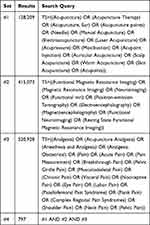 |
Table 1 The Topic Search Query |
Analysis Tool
The map generated by CiteSpace consists of citation tree-rings and lines. The citation tree-rings represent the frequency of occurrence and citation frequency of the analyzed documents. The color of the citation tree-rings represents the corresponding citation time, and the thickness of a ring is proportional to the number of citations in the corresponding period. The line between points indicates the co-occurrence relationship, its thickness indicates the intensity of co-occurrence, and the color corresponds to the first co-occurrence time of the node. The change of color from cool to warm indicates the change of time from early to recent. Betweenness centrality is an index to measure the importance of nodes in a network. CiteSpace uses this indicator to discover and measure the significance of literature and highlights such literature (or authors, journals, and institutions) with a purple circle.
We used CiteSpace 5.8.R3 to perform the bibliometric analysis:1. To generate annual distribution maps of the literature to identify publication volumes and trends. We analyzed data at macro, meso, and micro levels for countries, institutions, and authors’ collaboration networks to illustrate the overall research status. 2. Keyword co-occurrence analysis and keyword clustering analysis were performed to anchor research hotspots. 3. Co-citation analysis of references were performed to target frontier areas. The parameters of CiteSpace were as follows: the time slice was 2001–2021, the year in per slice was 1, the terms were selected as “Title,” “Abstract,” “Author Keywords,” and “Keywords Plus,” the number of objects in each time slice was set to 50, and the minimum spanning tree algorithm was used.
Results
Annual Publications and Trends
By searching the database, a total of 797 articles matching this study were included. Figure 1 shows the specific number of articles published per year. From 2001 to 2021, the number of articles on fMRI studies on acupuncture analgesia showed a fluctuating but generally rising trend. From 2001 to 2004, there were few fMRI studies on acupuncture analgesia, indicating low research interest in this area. The first period of rapid growth was shown between 2005 and 2007, with the first peak in the number of publications occurring in 2007, indicating that the importance of fMRI studies on acupuncture analgesia has been noticed. From 2008 to 2013, a period of stability occurred. The second growth peak showed in 2014, and from 2015 to 2021 the number of publications presented a slow growth trend. The results reveal that fMRI studies on acupuncture analgesia have received continued attention in recent years, and new studies are constantly being conducted.
 |
Figure 1 Annual publications involving fMRI studies on acupuncture analgesia. |
Analysis of Journals
A total of 367 journals contained these 797 fMRI studies on acupuncture analgesia. Table 2 lists the top 10 journals. The journals with the most published articles were Evidence-Based Complementary and Alternative Medicine and Medicine with 21 articles each, followed by Spine with 18 articles. Regional Anesthesia and Pain Medicine, ranked 7th with the highest impact factor (IF) of 7.015.
 |
Table 2 Top 10 Journals with the Highest Frequency Related to fMRI Studies on Acupuncture Analgesia |
Analysis of Cited Journals
Journal co-citation analysis analyzes the journals in which the references are located and can be used to identify hot journals and for the latest literature information tracking or manuscript submission. Figure 2 and Table 3 show the co-citations of journals in the field of fMRI studies on acupuncture analgesia in the last 20 years. It was found that Pain and Neuroimage had the highest citation frequency and was a core journal and an important reference journal in fMRI studies on acupuncture analgesia. Radiology and New England Journal of Medicine had the highest centrality, indicating that articles published in these two journals were influential in the field of fMRI studies on acupuncture analgesia.
 |
Table 3 Top 5 Cited Journals with the Highest Frequency and Centrality Related to fMRI Studies on Acupuncture Analgesia |
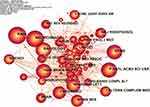 |
Figure 2 Co-citation map of journals related to fMRI studies on acupuncture analgesia. |
Figure 3 is a dual-map overlay of references in fMRI studies on acupuncture analgesia. The citing journals are on the left and the cited journals are on the right. The reference links originate from journals on the left side of the map and point to journals on the right side of the map. The color of the links distinguishes the discipline of the source. The vertical axis of the ellipse in the map represents the number of papers and the horizontal axis represents the number of authors. As shown in the map, the most contributed journals are from Pain, Neuroimage, Human Brain Mapping and New England Journal of Medicine. The citing journals are mainly in the fields of medicine, molecular, sports and immunology, and the cited journals are mainly in the fields of health, biology, medicine and genetics.
 |
Figure 3 The dual-map overlay of journals related to fMRI studies on acupuncture analgesia. |
Analysis of Authors and Institutions
CiteSpace software was used to generate an author-institution collaboration map (Figure 4) containing 631 nodes and 481 links. The top five authors with the most publications (Table 4) were Qin W (16 articles), Kong J (14 articles), Tian J (14 articles), Napadow V (14 articles), and Liang FR (10 articles). The top 5 institutions with the highest number of publications were Massachusetts General Hospital (34 articles), Harvard University (29 articles), Xidian University (26 articles), Chengdu University of Traditional Chinese Medicine (22 articles), and Chinese Academy of Sciences (21 articles). We performed cluster analysis on the generated map and retained the eight largest clusters. By observing the clustering map, we could find the closeness of the authors’ connections and their affiliations, and learned about the key issues studied by each team.
 |
Table 4 Top 5 Authors and Institutions with the Highest Frequency Related to fMRI Studies on Acupuncture Analgesia |
 |
Figure 4 Author-institution collaboration map related to fMRI studies on acupuncture analgesia. |
Analysis of Countries
We used CiteSpace software to generate the country collaboration network map (Table 5 and Figure 5). We found that articles on fMRI studies on acupuncture analgesia mainly came from 60 countries. The top 5 countries in terms of the number of publications were USA (212 articles), China (181 articles), South Korea (65 articles), Germany (49 articles), and Japan (49 articles). The top 5 countries in terms of centrality were USA (0.35), China (0.11), Germany (0.11), England (0.11), and Switzerland (0.11).
 |
Table 5 Top 5 Countries with the Highest Frequency and Centrality Related to fMRI Studies on Acupuncture Analgesia |
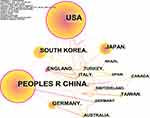 |
Figure 5 Co-country map related to fMRI studies on acupuncture analgesia. |
Analysis of Cited Authors
Author co-citation refers to two (or more) authors being cited simultaneously in one or more subsequent papers. It can be used to explore authors with highly similar research directions. We used CiteSpace software to generate a cited author map consisting of 671 nodes and 270 lines (Table 6 and Figure 6). The top five most-cited authors were Hui KKS (111 articles), Kong J (87 articles), Napadow V (80 articles), Wu MT (54 articles), and Han JS (49 articles). The top five authors ranked according to centrality were Casey KL (0.19), Bohannon R (0.18), Mense S (0.17), Brukner P (0.15), and Kelly M (0.14).
 |
Table 6 Top 5 Cited Authors with the Highest Frequency and Centrality Related to fMRI Studies on Acupuncture Analgesia |
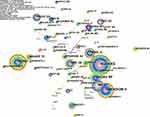 |
Figure 6 Cited authors map related to fMRI studies on acupuncture analgesia. |
Analysis of Cited References
Reference co-citation refers to two (or more) papers being cited by one or more papers simultaneously and is used to assess the degree of correlation between the papers. Reference co-citation relationships vary over time and its study allows exploring the development and evolutionary dynamics of a particular study. We obtained the reference co-citation map of fMRI studies on acupuncture analgesia in the last 20 years using CiteSpace (Figure 7), with 743 nodes and 708 links. And the top 5 most cited references and the highest centrality of fMRI studies on acupuncture analgesia for the last 20 years were listed in Tables 7 and 8. We performed a cluster analysis of the co-citation references in order to uncover common themes in similar articles. A total of 13 clusters were obtained. The largest group was “brain mapping” which contains 62 references. The clusters “chronic low back pain” and “specific effect” were the lightest in color, indicating the most recent direction of fMRI research on acupuncture analgesia.
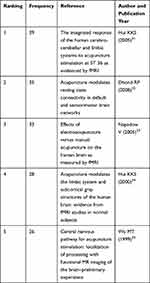 |
Table 7 Top 5 Cited References with the Highest Frequency Related to fMRI Studies on Acupuncture Analgesia |
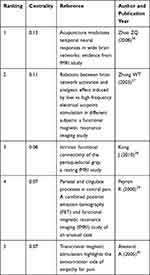 |
Table 8 Top 5 Cited References with the Highest Centrality Related to fMRI Studies on Acupuncture Analgesia |
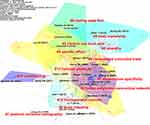 |
Figure 7 Cited references map related to fMRI studies on acupuncture analgesia. |
Keywords Co-Occurrence Analysis
Keywords with high frequency and high centrality can explore the core issues and research hotspots that are widely concerned in the field. We used CiteSpace to analyze the co-occurrence of keywords, and 483 nodes and 886 lines were obtained (Figure 8 and Table 9). We sorted and summarized the frequency and centrality of the keywords in Table 9. Over the past 20 years, the most frequently used keywords in fMRI studies on acupuncture analgesia were “pain,” “fMRI,” “low back pain,” “stimulation,” and “activation.” The top five high-centrality keywords were “pain”, “analgesia”, “management”, “low back pain” and “diagnosis”.
 |
Table 9 Top 10 Keywords with the Highest Frequency and Centrality Related to fMRI Studies on Acupuncture Analgesia |
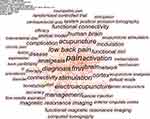 |
Figure 8 Keywords co-occurrence map related to fMRI studies on acupuncture analgesia. |
References Timeline Analysis
The logarithmic likelihood ratio (LLR) method was used to cluster the references. It is generally accepted that a clustering modularity value (Q) > 0.3 suggests a significant clustering structure, and a mean silhouette value (S) > 0.5 implies that the clusters are convincing. A total of 13 clusters were obtained, with Q values of 0.8496 and S values of 0.9634. We listed the top 10 most significant clusters (Figure 9), with “brain mapping” being the most prominent cluster, containing 62 articles. We used a timeline view to present the period of each cluster and the association between the different clusters, which demonstrated the evolution of fMRI studies on acupuncture analgesia. By observing the map, we can see that the “specific effect” and “lower back pain” are warm and on the right side of the time axis, indicating that they are the research hotspots in recent years.
 |
Figure 9 References timeline map related to fMRI studies on acupuncture analgesia. |
Citation Burst Analysis
Citation burst refers to a significant increase in the frequency of usage within a short period. It can clarify the research focus and hotspot at a particular time and determine the development tends and research frontier. The start and end times of the burst are represented by “begin” and “end.” The higher the value of “intensity,” the more significant the impact. The light blue part represents the period of this study, and the red part represents the beginning and end of a burst. The keyword citation burst map (Figure 10A) shows that the most crucial keyword is “stimulation,” with an intensity of 6.38. It started to become important from 2009 to 2011. The “human brain” is the keyword with the most extended duration (7 years). “Functional connectivity” is a hot research topic that started to appear in 2018. Observing the citation burst of references (Figure 10B), we find that Hui KKS (2005) has the highest intensity value of 10.42. The articles by Kong J (2018) and Egorova N (2015) have seen a surge in citations starting in 2019.
 |
Figure 10 (A) Top 10 keywords with the strongest citation bursts. (B) Top 25 references with the strongest citation bursts. |
Discussion
Basic Information
The trend of publications shows that fMRI studies on acupuncture analgesia had a massive leap from 2004 to 2007 and then maintained a fluctuating rise with an overall increasing trend. This change may be related to the emphasis on pain disorders and the development of fMRI techniques, and intensive research on acupuncture analgesia.
In terms of authors, the author teams represented Qin W (16 articles), Kong J (14 articles), Tian J (14 articles), Napadow V (14 articles), and Liang FR (14 articles) had published more articles. Qin W was dedicated to computational neuroscience and the study of acupuncture mechanisms and placebo effects. One of his studies, cited 107 times, found that acupuncture can act on the resting network, thus contributing to the potential role of endogenous pain modulation circuits and homeostatic control mechanisms.41 Kong J, the second most published author, found that expectancy can significantly modulate pain and was associated with medial prefrontal cortex (MPFC)/cranial anterior cingulate cortex (RACC) and dorsolateral prefrontal cortex.42 By analyzing the high-frequency authors, we can figure out the research direction of each author and grasp the research hotspots.
The five institutions with the most publications were Massachusetts General Hospital (34 articles), Harvard University (29 articles), Xidian University (26 articles), Chengdu University of Traditional Chinese Medicine (22 articles), and Chinese Academy of Sciences (21 articles). For fMRI studies on acupuncture analgesia, three leading institutions can be found: universities, hospitals, and research institutions. However, universities were still the mainstay of research. The high centrality of Chinese research institutions suggested that China, as the birthplace of acupuncture, played a vital role in the international cooperation of fMRI studies on acupuncture analgesia. Analysis of the color of the circles and lines yielded that the number of institutional publications and inter-institutional collaboration in the early years was small. However, in recent years, the number of publications and inter-institutional connections has increased significantly. We generated author-institution collaboration clustering maps and found that authors and institutions formed several natural clusters. Author-institution collaboration was close within clusters and less between clusters, consistent with our previous analysis. We performed keyword clustering of authors’ research directions to find out the topics of interest for each cluster. We discovered that the primary research disease of the team of Liang Fanrong, Zeng Fang, and Lan Lei from Chengdu University of Traditional Chinese Medicine was migraine without aura,43,44 the main research direction of the team from Kyung Hee University was cancer pain in rats,45,46 and the central research disease of the teams from Massachusetts General Hospital as well as Harvard University were chronic lower back pain.47,48
In terms of frequency of publication, the USA had the highest number of articles with 212, followed by China with 181 articles. This indicates that the contribution rates of the USA and China are high and much higher than other countries. In terms of centrality, the USA had a high centrality of 0.35, suggesting that most countries in the co-occurrence network had direct and indirect collaborations with the USA. Therefore, it is clear that the USA has a vital role in fMRI studies on acupuncture analgesia. This also demonstrates that the development of scientific research is inextricably linked to the economy. The centrality of Switzerland, England, and Germany was also high, which may be related to the geographical location. The presence of connections between the USA, China, Korea, Japan, Germany, and Italy, and many new connections in the map, illustrates that international cooperation in fMRI studies on acupuncture analgesia has developed and is gradually increasing to a certain extent.
Hui KKS, as the most highly cited author, focused on fMRI studies of acupuncture. One of his studies demonstrated that acupuncture activated the limbic-paralimbic-neocortical network and its anti-related sensorimotor/paralimbic network at multiple levels of the brain.49 Kong J from Massachusetts General Hospital Psychiatry focused on central mechanisms of placebo acupuncture related to pain, and they suggested that as a peripheral-central modulation, acupuncture stimulation may inhibit incoming noxious stimuli. In contrast, as a top-down modulation, anticipation (placebo) may act through emotional circuits.50 As the author with the highest centrality, Cho ZH found ancient acupuncture literature correlated with the predicted activation of specific cerebral cortical regions and the corresponding acupuncture stimulation.51 The top three cited articles were randomized controlled trials (RCTs) published in Neuroimaging, Pain, and Human Brain Mapping. The second most cited paper was by Dhond RP, suggested that TA elicits richer and more intense sensations compared to SA and that acupuncture enhances the spatial extent of the resting brain network after stimulation and elicits a sympathetic vagal response, which may be a potential mechanism of therapeutic effect of acupuncture analgesia.32 The article with the highest centrality was by Zhao ZQ, found that acupuncture analgesia was time-dependent and may be involved in different temporal neural responses by using fMRI to study acupuncture at Zusanli (ST36).52
Research Hotspots
Research hotspots are scientific issues and topics discussed by a relatively large number of documents in a certain period. From the perspective of bibliometrics, the most frequently cited documents are usually a concentrated expression of research hotspots in this field. To a certain extent, keywords that appear more frequently also represent research hotspots. We analyzed the cited maps and keyword clustering maps, it was found that the hot research disease in fMRI studies on acupuncture analgesia was low back pain, and the hot research content included acupuncture specific and frequency specificity.
Research Diseases
FMRI studies on acupuncture analgesia involved 16 diseases, of which lower back pain (52 articles) was the hot spot, followed by migraine (30 articles), cancer pain (17 articles), chronic pain (12 articles), neuropathic pain (9 articles), back pain (8 articles), stomach pain (8 articles), osteoarthritis (7 articles), shoulder pain (6 articles), headache (6 articles), irritable bowel syndrome (6 articles), neck pain (5 articles), radicular pain (5 articles) pelvic pain (2 articles), tennis elbow pain (2 articles), heel pain (1 article), and leg pain (1 article). Studies of acupuncture for lower back pain included clinical studies and animal trials. One of the most cited animal studies verified that caspase 3 knockout in rabbit intervertebral disc cells effectively prevented apoptosis and thus regulated disc degeneration.53 The most cited clinical study reported that continuous true electroacupuncture (EA) stimulation could modify the coupling of spontaneous activity in brain regions of patients with low back pain, thus playing an essential role in pain modulation.54 In a highly cited literature on fMRI studies on acupuncture for migraine, it was found that acupuncture stimulation of different acupoints on similar body regions in migraine patients reduced pain and induced different degrees of cerebral glucose metabolism in brain-related brain regions.43
Research Contents
Hot research components of fMRI studies on acupuncture analgesia included acupuncture specificity and frequency specificity. Although the analgesic effect of acupuncture is clinically effective, its specificity has been questioned. Several studies have shown that nonspecific comfort factors (eg, efficacy expectations) and confounding factors (eg, spontaneous relief) largely contribute to the efficacy of acupuncture.55,56 The development of neuroimaging techniques has provided new means to verify the specificity of acupoints. One study found that TA versus SA stimulation modulated brain function differently.57 A meta-analysis revealed that acupuncture was effective in treating chronic pain, with significant differences between RA and SA suggesting that acupuncture was more effective than placebo.56 An fMRI study showed no specific effect of RA versus SA on primary auditory cortex.58 Another study found that RA versus SA activated secondary somatosensory cortical areas, frontal areas, the right side of the thalamus, and the left side of the cerebellum. These specific brain patterns may explain the therapeutic effects of acupuncture. Due to the complexity of brain function and the diversity of acupuncture manipulations, it is common for neuroimaging studies to show opposite results. The reliability of neuroimaging studies can be increased by increasing the sample size, refining the experimental design, correct and diverse analysis methods, and appropriate selection of acupuncture methods.59
Different frequencies of EA induced the release of different kinds of neuropeptides in the center, producing different physiological and therapeutic effects.60 EA stimulation at different wavelengths resulted in different degrees of functional connectivity of brain regions and significantly different pain thresholds.61 One study further found that acupoint electrical stimulation (EAS) at 2 Hz or 100 Hz induced analgesia through different central mechanisms.37 This also suggests that reasonable parameter settings are crucial to influence the efficacy of acupuncture.
Acupuncture Analgesia-Related Brain Areas
In the study anterior cingulate cortex (ACC), default mode network, periaqueductal gray (PAG), #3 limbic-paralimbic-neocortical network, and #12 frontoparietal network appeared in the keyword co-occurrence network and the reference clustering map.
Over the past few decades, studies have identified possible neural substrates of pain, contained in a network of underlying brain areas, that are fundamental to the processing and experience of pain.62 But there is no definite consensus on all regions involved in this pain network. In the present study, ACC and PAG were found to be key brain areas for acupuncture analgesia. ACC, as part of the central nervous system, is involved not only in emotion regulation, motivation, behavioral assessment, and error recognition but also in the development of chronic pain perception, especially pain-related emotions and moods.63,64 Several neuroimaging studies found that acupuncture caused a significant delay and long-term sustained increase in signals in the ACC area of the brain.32,65 In patients with knee osteoarthritis, increased functional connectivity in ACC brain areas was significantly associated with a reduction in knee pain after acupuncture treatment.42,66 The PAG is an important component of the downstream pain regulatory network that inhibits or excites pain transmission.67,68 It is involved in the endogenous analgesic system produced by acupuncture stimulation.69 EA increased the expression of pain-related factors in the PAG, resulting in a positive analgesic effect in nicotine-exposed pain-sensitive rats.70 Acupuncture restored the balance of PAG connections to key pain brain areas in the medial frontal cortex (MFC) and bilateral hippocampus (Hpc), thereby modulating chronic pain in osteoarthritis of the knee.71 The PAG was a key region of the descending pain modulatory system (DPMS) in patients with migraine without aura (MwoA).72 The results of this study revealed that all pain disorders have abnormalities in the structure and function of the relevant brain regions. Summarizing the important brain regions for disease pathogenesis can provide targets and more feasible solutions for acupuncture analgesic treatment in clinical practice.
Research Frontiers and Trends
By observing the citation timeline map of the references (Figure 9), we can know the time of the first citation, the total number of citations (the size of the circle), and the last citation of each reference. The earliest cited literature appeared in 1996 (1996–2004), and the keywords were brain mapping and positron emission tomography, indicating that early neuroimaging research mainly used these two technical tools. From 2004 to 2013, the keywords of the most cited references were acupuncture specificity, limbic-paralimbic-neocortical network, randomized controlled trials, and empathy. From 2009 to 2015, the keywords were body ownership and resting state fMRI, showing that resting state fMRI began to emerge in large numbers and became a research hotspot at this time. From 2013 to 2020, the hot keywords were chronic low back pain and specific effect. This indicates that chronic low back pain and specificity have been hot research topics in recent years and will continue to be hot topics.
Limitation
This study also has certain limitations. First, only the WOS database was analyzed, as CiteSpace cannot merge and analyze the content of multiple databases, nor can it perform citation analysis on source data outside of WOS. In addition, the article did not provide a detailed and specific description of the central mechanism of acupuncture analgesia, as CiteSpace is used to identify and demonstrate new trends and developments in disciplines. We aim to present the research progress and current research frontiers in the neuroimaging field of acupuncture analgesia through the CiteSpace.
Abbreviations
RCT, randomized controlled trial; fMRI, functional magnetic resonance imaging; IF, impact factor; WOS, Web of Science; SA, sham acupuncture; TA, true acupuncture; EA, electroacupuncture; ACC, anterior cingulate cortex; PAG, periaqueductal gray.
Data Sharing Statement
The raw data can be accessed directly from the online database Science Citation Index-Expanded (SCI-E) of Thomson Reuters’ WOS.
Acknowledgments
The authors would like to express their appreciation to Prof. Chaomei Chen, who invented CiteSpace and made it open for use.
Author Contributions
All authors made a significant contribution to the work reported, whether that was in the conception, study design, execution, acquisition of data, analysis and interpretation, or in all these areas; took part in drafting, revising or critically reviewing the article; gave final approval of the version to be published; have agreed on the journal to which the article has been submitted; and agreed to be accountable for all aspects of the work.
Funding
This study was supported by the National Natural Science Foundation of China (81774400); the Key Research Program of Science and Technology Department of Sichuan Province (21ZDYF0805).
Disclosure
The authors declare that they have no potential conflicts of interest in this study.
References
1. Raja SN, Carr DB, Cohen M, et al. The revised international association for the Study of Pain definition of pain: concepts, challenges, and compromises. Pain. 2020;161(9):1976–1982. doi:10.1097/j.pain.0000000000001939
2. Seers T, Derry S, Seers K, Moore RA. Professionals underestimate patients’ pain: a comprehensive review. Pain. 2018;159(5):811–818. doi:10.1097/j.pain.0000000000001165
3. Pizzo P, Clark NM, Carter-Pokras O, Christopher M, Farrar JT, Follett KA. Relieving pain in America: a blueprint for transforming prevention, care, education, and research. Mil Med. 2016;181(5):397–399. doi:10.7205/MILMED-D-16-00012
4. Woolf CJ. Central sensitization: implications for the diagnosis and treatment of pain. Pain. 2011;152(3 Suppl):S2–S15. doi:10.1016/j.pain.2010.09.030
5. Moulin DE, Clark AJ, Gilron I, et al. Pharmacological management of chronic neuropathic pain - consensus statement and guidelines from the Canadian pain society. Pain Res Manag. 2007;12(1):13–21. doi:10.1155/2007/730785
6. Angst MS, Phillips NG, Drover DR, et al. Pain sensitivity and opioid analgesia: a pharmacogenomic twin study. Pain. 2012;153(7):1397–1409. doi:10.1016/j.pain.2012.02.022
7. Ilfeld BM. Continuous peripheral nerve blocks: a review of the published evidence. Anesth Analg. 2011;113(4):904–925. doi:10.1213/ANE.0b013e3182285e01
8. Benyamin R, Trescot AM, Datta S, et al. Opioid complications and side effects. Pain Physician. 2008;11(2 Suppl):S105–S120. doi:10.36076/ppj.2008/11/S105
9. Rudd RA, Aleshire N, Zibbell JE, Gladden RM. Increases in drug and opioid overdose deaths–United States, 2000–2014. MMWR Morb Mortal Wkly Rep. 2016;64(50–51):1378–1382. doi:10.15585/mmwr.mm6450a3
10. Schreijenberg M, Koes BW, Lin CC. Guideline recommendations on the pharmacological management of non-specific low back pain in primary care - is there a need to change? Expert Rev Clin Pharmacol. 2019;12(2):145–157. doi:10.1080/17512433.2019.1565992
11. Schnabel A, Poepping DM, Kranke P, Zahn PK, Pogatzki-Zahn EM. Efficacy and adverse effects of ketamine as an additive for paediatric caudal anaesthesia: a quantitative systematic review of randomized controlled trials. Br J Anaesth. 2011;107(4):601–611. doi:10.1093/bja/aer258
12. Zhao L, Chen J, Li Y, et al. The long-term effect of acupuncture for migraine prophylaxis: a randomized clinical trial. JAMA Intern Med. 2017;177(4):508–515. doi:10.1001/jamainternmed.2016.9378
13. Xu S, Yu L, Luo X, et al. Manual acupuncture versus sham acupuncture and usual care for prophylaxis of episodic migraine without aura: multicentre, randomised clinical trial. BMJ. 2020;368:m697. doi:10.1136/bmj.m697
14. Tu JF, Yang JW, Shi GX, et al. Efficacy of intensive acupuncture versus sham acupuncture in knee osteoarthritis: a randomized controlled trial. Arthritis Rheumatol. 2021;73(3):448–458. doi:10.1002/art.41584
15. Wang TQ, Li YT, Wang LQ, et al. Electroacupuncture versus manual acupuncture for knee osteoarthritis: a randomized controlled pilot trial. Acupunct Med. 2020;38(5):291–300. doi:10.1177/0964528419900781
16. Calamita SAP, Biasotto-Gonzalez DA, De Melo NC, et al. Immediate effect of acupuncture on electromyographic activity of the upper trapezius muscle and pain in patients with nonspecific neck pain: a Randomized, Single-Blinded, Sham-Controlled, Crossover Study. J Manipulative Physiol Ther. 2018;41(3):208–217. doi:10.1016/j.jmpt.2017.09.006
17. Chen L, Li M, Fan L, et al. Optimized acupuncture treatment (acupuncture and intradermal needling) for cervical spondylosis-related neck pain: a multicenter randomized controlled trial. Pain. 2021;162(3):728–739. doi:10.1097/j.pain.0000000000002071
18. Estores I, Chen K, Jackson B, Lao L, Gorman PH. Auricular acupuncture for spinal cord injury related neuropathic pain: a pilot controlled clinical trial. J Spinal Cord Med. 2017;40(4):432–438. doi:10.1080/10790268.2016.1141489
19. Zhao L, Li D, Zheng H, et al. Acupuncture as adjunctive therapy for chronic stable angina: a randomized clinical trial. JAMA Intern Med. 2019;179(10):1388–1397. doi:10.1001/jamainternmed.2019.2407
20. Sun Y, Liu Y, Liu B, et al. Efficacy of acupuncture for chronic prostatitis/chronic pelvic pain syndrome: a randomized trial. Ann Intern Med. 2021;174(10):1357–1366. doi:10.7326/M21-1814
21. Chen S, Li X. Functional magnetic resonance imaging for imaging neural activity in the human brain: the annual progress. Comput Math Methods Med. 2012;2012:613465. doi:10.1155/2012/613465
22. Li A, Li XL, Zhang F, et al. A functional magnetic resonance imaging study of the neuronal specificity of an acupoint: acupuncture at Rangu (KI 2) and its sham point. Intern Med J. 2016;46(8):973–977. doi:10.1111/imj.13154
23. Yu SW, Lin SH, Tsai CC, et al. Acupuncture effect and mechanism for treating pain in patients with parkinson’s disease. Front Neurol. 2019;10:1114. doi:10.3389/fneur.2019.01114
24. Zhang S, Wang X, Yan CQ, et al. Different mechanisms of contralateral- or ipsilateral-acupuncture to modulate the brain activity in patients with unilateral chronic shoulder pain: a pilot fMRI study. J Pain Res. 2018;11:505–514. doi:10.2147/JPR.S152550
25. Wen Q, Ma P, Dong X, et al. Neuroimaging studies of acupuncture on low back pain: a systematic review. Front Neurosci. 2021;15:730322. doi:10.3389/fnins.2021.730322
26. Tu Y, Zeng F, Lan L, et al. An fMRI-based neural marker for migraine without aura. Neurology. 2020;94(7):e741–e751. doi:10.1212/WNL.0000000000008962
27. Cao J, Tu Y, Orr SP, et al. Analgesic effects evoked by real and imagined acupuncture: a Neuroimaging Study. Cereb Cortex. 2019;29(8):3220–3231. doi:10.1093/cercor/bhy190
28. Ma K, Liu Y, Shao W, et al. Brain functional interaction of acupuncture effects in diarrhea-dominant irritable bowel syndrome. Front Neurosci. 2020;14:608688. doi:10.3389/fnins.2020.608688
29. Luo W, Zhang Y, Yan Z, et al. The instant effects of continuous transcutaneous auricular vagus nerve stimulation at acupoints on the functional connectivity of amygdala in migraine without aura: a Preliminary Study. Neural Plast. 2020;2020:8870589. doi:10.1155/2020/8870589
30. Chen C. Searching for intellectual turning points: progressive knowledge domain visualization. Proc Natl Acad Sci U S A. 2004;101 Suppl 1(Suppl1):5303–5310. doi:10.1073/pnas.0307513100
31. Hui KK, Liu J, Marina O, et al. The integrated response of the human cerebro-cerebellar and limbic systems to acupuncture stimulation at ST 36 as evidenced by fMRI. NeuroImage. 2005;27(3):479–496. doi:10.1016/j.neuroimage.2005.04.037
32. Dhond RP, Yeh C, Park K, Kettner N, Napadow V. Acupuncture modulates resting state connectivity in default and sensorimotor brain networks. Pain. 2008;136(3):407–418. doi:10.1016/j.pain.2008.01.011
33. Napadow V, Makris N, Liu J, Kettner NW, Kwong KK, Hui KK. Effects of electroacupuncture versus manual acupuncture on the human brain as measured by fMRI. Hum Brain Mapp. 2005;24(3):193–205. doi:10.1002/hbm.20081
34. Hui KK, Liu J, Makris N, et al. Acupuncture modulates the limbic system and subcortical gray structures of the human brain: evidence from fMRI studies in normal subjects. Hum Brain Mapp. 2000;9(1):13–25. doi:10.1002/(SICI)1097-0193(2000)9:1<13::AID-HBM2>3.0.CO;2-F
35. Wu MT, Hsieh JC, Xiong J, et al. Central nervous pathway for acupuncture stimulation: localization of processing with functional MR imaging of the brain–preliminary experience. Radiology. 1999;212(1):133–141. doi:10.1148/radiology.212.1.r99jl04133
36. Bai L, Tian J, Zhong C, et al. Acupuncture modulates temporal neural responses in wide brain networks: evidence from fMRI study. Mol Pain. 2010;6:73. doi:10.1186/1744-8069-6-73
37. Zhang WT, Jin Z, Cui GH, et al. Relations between brain network activation and analgesic effect induced by low vs. high frequency electrical acupoint stimulation in different subjects: a functional magnetic resonance imaging study. Brain Res. 2003;982(2):168–178. doi:10.1016/S0006-8993(03)02983-4
38. Kong J, Tu PC, Zyloney C, Su TP. Intrinsic functional connectivity of the periaqueductal gray, a resting fMRI study. Behav Brain Res. 2010;211(2):215–219. doi:10.1016/j.bbr.2010.03.042
39. Peyron R, García-Larrea L, Grégoire MC, et al. Parietal and cingulate processes in central pain. A combined positron emission tomography (PET) and functional magnetic resonance imaging (fMRI) study of an unusual case. Pain. 2000;84(1):77–87. doi:10.1016/S0304-3959(99)00190-6
40. Avenanti A, Bueti D, Galati G, Aglioti SM. Transcranial magnetic stimulation highlights the sensorimotor side of empathy for pain. Nat Neurosci. 2005;8(7):955–960. doi:10.1038/nn1481
41. Bai L, Qin W, Tian J, et al. Acupuncture modulates spontaneous activities in the anticorrelated resting brain networks. Brain Res. 2009;1279:37–49. doi:10.1016/j.brainres.2009.04.056
42. Kong J, Wang Z, Leiser J, et al. Enhancing treatment of osteoarthritis knee pain by boosting expectancy: a functional neuroimaging study. NeuroImage Clin. 2018;18:325–334. doi:10.1016/j.nicl.2018.01.021
43. Yang J, Zeng F, Feng Y, et al. A PET-CT study on the specificity of acupoints through acupuncture treatment in migraine patients. BMC Complement Altern Med. 2012;12:123. doi:10.1186/1472-6882-12-123
44. Zhao L, Liu J, Zhang F, et al. Effects of long-term acupuncture treatment on resting-state brain activity in migraine patients: a randomized controlled trial on active acupoints and inactive acupoints. PLoS One. 2014;9(6):e99538.
45. Lee HJ, Lee JH, Lee EO, et al. Substance P and beta endorphin mediate electroacupuncture induced analgesic activity in mouse cancer pain model. Acupunct Electrother Res. 2009;34(1–2):27–40. doi:10.3727/036012909803861095
46. Lee HJ, Lee JH, Lee EO, et al. Retraction: substance P and beta-endorphin mediate electro-acupuncture induced analgesia in mouse cancer pain model. J Exp Clin Cancer Res. 2009;28(1):137. doi:10.1186/1756-9966-28-137
47. Haig AJ, Geisser ME, Tong HC, et al. Electromyographic and magnetic resonance imaging to predict lumbar stenosis, low-back pain, and no back symptoms. J Bone Joint Surg Am. 2007;89(2):358–366. doi:10.2106/JBJS.E.00704
48. Last AR, Hulbert K. Chronic low back pain: evaluation and management. Am Fam Physician. 2009;79(12):1067–1074.
49. Hui KK, Napadow V, Liu J, et al. Monitoring acupuncture effects on human brain by FMRI. J Vis Exp. 2010;38:e1190.
50. Kong J, Kaptchuk TJ, Polich G, et al. An fMRI study on the interaction and dissociation between expectation of pain relief and acupuncture treatment. NeuroImage. 2009;47(3):1066–1076. doi:10.1016/j.neuroimage.2009.05.087
51. Cho ZH, Chung SC, Jones JP, et al. New findings of the correlation between acupoints and corresponding brain cortices using functional MRI. Proc Natl Acad Sci U S A. 1998;95(5):2670–2673. doi:10.1073/pnas.95.5.2670
52. Zhao ZQ. Neural mechanism underlying acupuncture analgesia. Prog Neurobiol. 2008;85(4):355–375. doi:10.1016/j.pneurobio.2008.05.004
53. Sudo H, Minami A. Caspase 3 as a therapeutic target for regulation of intervertebral disc degeneration in rabbits. Arthritis Rheum. 2011;63(6):1648–1657. doi:10.1002/art.30251
54. Zyloney CE, Jensen K, Polich G, et al. Imaging the functional connectivity of the periaqueductal gray during genuine and sham electroacupuncture treatment. Mol Pain. 2010;6:80. doi:10.1186/1744-8069-6-80
55. Kaptchuk TJ, Kelley JM, Conboy LA, et al. Components of placebo effect: randomised controlled trial in patients with irritable bowel syndrome. BMJ. 2008;336(7651):999–1003. doi:10.1136/bmj.39524.439618.25
56. Vickers AJ, Cronin AM, Maschino AC, et al. Acupuncture for chronic pain: individual patient data meta-analysis. Arch Intern Med. 2012;172(19):1444–1453. doi:10.1001/archinternmed.2012.3654
57. Zhu B, Wang Y, Zhang G, et al. Acupuncture at KI3 in healthy volunteers induces specific cortical functional activity: an fMRI study. BMC Complement Altern Med. 2015;15:361.
58. Wesolowski T, Lotze M, Domin M, et al. Acupuncture reveals no specific effect on primary auditory cortex: a functional magnetic resonance imaging study. Neuroreport. 2009;20(2):116–120. doi:10.1097/WNR.0b013e328321004d
59. Bennett CM, Miller MB. How reliable are the results from functional magnetic resonance imaging? Ann N Y Acad Sci. 2010;1191:133–155. doi:10.1111/j.1749-6632.2010.05446.x
60. Zhong F, Wu LZ, Han JS. Suppression of cue-induced heroin craving and cue-reactivity by single-trial transcutaneous electrical nerve stimulation at 2 Hz. Addict Biol. 2006;11(2):184–189. doi:10.1111/j.1369-1600.2006.00020.x
61. You Y, Bai L, Dai R, et al. Acupuncture induces divergent alterations of functional connectivity within conventional frequency bands: evidence from MEG recordings. PLoS One. 2012;7(11):e49250. doi:10.1371/journal.pone.0049250
62. Tracey I, Mantyh PW. The cerebral signature for pain perception and its modulation. Neuron. 2007;55(3):377–391. doi:10.1016/j.neuron.2007.07.012
63. Stevens FL, Hurley RA, Taber KH, Hurley RA, Hayman LA, Taber KH. Anterior cingulate cortex: unique role in cognition and emotion. J Neuropsychiatry Clin Neurosci. 2011;23(2):121–125. doi:10.1176/jnp.23.2.jnp121
64. Truini A, Tinelli E, Gerardi MC, et al. Abnormal resting state functional connectivity of the periaqueductal grey in patients with fibromyalgia. Clin Exp Rheumatol. 2016;34(2 Suppl 96):S129–S133.
65. Murase T, Umeda M, Higuchi T. Investigation of acupuncture-specific BOLD signal changes using multiband acquisition and deconvolution analysis. Magn Reson Med Sci. 2021. doi:10.2463/mrms.mp.2020-0164
66. Chen X, Spaeth RB, Retzepi K, Ott D, Kong J. Acupuncture modulates cortical thickness and functional connectivity in knee osteoarthritis patients. Sci Rep. 2014;4:6482. doi:10.1038/srep06482
67. Coulombe MA, Erpelding N, Kucyi A, Davis KD. Intrinsic functional connectivity of periaqueductal gray subregions in humans. Hum Brain Mapp. 2016;37(4):1514–1530. doi:10.1002/hbm.23117
68. de Novellis V, Luongo L, Guida F, et al. Effects of intra-ventrolateral periaqueductal grey palmitoylethanolamide on thermoceptive threshold and rostral ventromedial medulla cell activity. Eur J Pharmacol. 2012;676(1–3):41–50. doi:10.1016/j.ejphar.2011.11.034
69. Moritaka K, Zeredo JL, Kimoto M, Nasution FH, Hirano T, Toda K. Response properties of nucleus reticularis lateralis neurons after electroacupuncture stimulation in rats. Am J Chin Med. 2010;38(5):869–880. doi:10.1142/S0192415X10008317
70. Wang SJ, Zhang YP, Candiotti KA. Effects of electroacupuncture on pain sensation in a rat model of hyperalgesia with nicotine dependence. Neural Regen Res. 2022;17(4):905–910. doi:10.4103/1673-5374.322477
71. Egorova N, Gollub RL, Kong J. Repeated verum but not placebo acupuncture normalizes connectivity in brain regions dysregulated in chronic pain. NeuroImage Clin. 2015;9:430–435. doi:10.1016/j.nicl.2015.09.012
72. Li Z, Liu M, Lan L, et al. Altered periaqueductal gray resting state functional connectivity in migraine and the modulation effect of treatment. Sci Rep. 2016;6:20298. doi:10.1038/srep20298
 © 2021 The Author(s). This work is published and licensed by Dove Medical Press Limited. The full terms of this license are available at https://www.dovepress.com/terms.php and incorporate the Creative Commons Attribution - Non Commercial (unported, v3.0) License.
By accessing the work you hereby accept the Terms. Non-commercial uses of the work are permitted without any further permission from Dove Medical Press Limited, provided the work is properly attributed. For permission for commercial use of this work, please see paragraphs 4.2 and 5 of our Terms.
© 2021 The Author(s). This work is published and licensed by Dove Medical Press Limited. The full terms of this license are available at https://www.dovepress.com/terms.php and incorporate the Creative Commons Attribution - Non Commercial (unported, v3.0) License.
By accessing the work you hereby accept the Terms. Non-commercial uses of the work are permitted without any further permission from Dove Medical Press Limited, provided the work is properly attributed. For permission for commercial use of this work, please see paragraphs 4.2 and 5 of our Terms.
